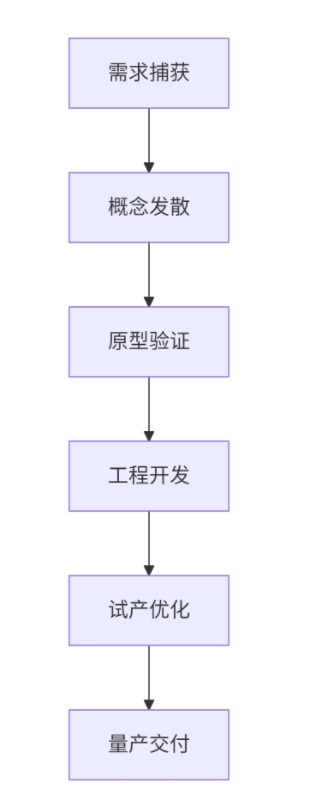1. Design philosophy and principles
Double helix design thinking
User demand axis: Mining explicit/implicit requirements through the Kano model
Technology implementation axis: Break through engineering contradictions based on TRIZ theory
The Law of Five-Dimensional Equilibrium
Functional realizability | Aesthetic appeal | Production feasibility
Use Security | Environmentally friendly
2. Product development process framework

3. Detailed explanation of the core design elements
1. Industrial Design Module
1.1 Morphological genetic design
Basic Geometry Derivation: 23 Cutting Deformation Schemes for Cubes/Cylinders/Spheres
Biomimetic pathway: 40% weight reduction rate >of honeycomb structure, 15% reduction of shark skin surface
1.2 CMF Strategy System
Elements of Decision Tree Typical Cases
Color: Pantone Trend Report, Scene Mood Board, Medical White (RAL 9016)
Material: Ashby Material Selection Matrix: Carbon Fiber Reinforced PEEK
Process DFM (Design for Manufacturing) IMD in-mold decoration technology
2. Structural Design Module
2.1 Mechanical architecture design
Topology optimization: Lightweighting (weight reduction ≥ 25%) with Altair OptiStruct
Failure Prevention:
Static Analysis (Safety Factor≥ 1.5)
Modal analysis (avoids the 50-200Hz resonance band)
2.2 Tolerance analysis system
Dimension Chain Calculations: Extreme Value/Worst Case vs. Statistical RSS
Key mating surface: shaft bore with H7/g6, flatness requirement ≤ 0.1mm/m
3. Human-computer interaction module
3.1 Five Senses Experience Design
Sensory Design Strategies Testing Criteria
Visual Fitz's Law Optimizes Operating Distances Eye Movement Trajectory Heatmap Analysis
Tactile, surface roughness, Ra0.4-1.6μm range, finger friction coefficient test
Auditory Acoustic Quality Parameters (Loudness/Sharpness) Psychoacoustic AI Evaluation Model
3.2 Interaction Logic Architecture
State Machine Design: Graphical representation of finite state machines (FSMs).
Fault Tree Analysis (FTA): covers 98% of potential anomalous scenarios
4. Encyclopedia of Materials and Processes
1. Metalworking process
1.1 The whole process of sheet metal

1.2 Special processes
Micro-arc oxidation: film thickness 50-100μm, hardness HV800
Metal Injection Molding (MIM): Suitable for complex and small parts (accuracy ± 0.3%)
2. Plastic molding technology
Process Wall thickness range Draft angle requirements Applicable materials
Injection molded 1-5mm ≥1° ABS/PC/PP
Blow molded 0.5-4mm symmetrical structure HDPE/PET
Blister molded 0.2-2mm freeform PVC/PS
5. Verification and testing system
1. Reliability Verification Matrix
The type of test is based on the key parameters
Environmental test IEC 60068 temperature cycle -40°C~85°C
Mechanical Test ISTA 3A Random Vibration 5Grms
Endurance Test MIL-STD-810 Key life 500,000 cycles
2. User scenario simulation
Flow analysis: Draw user flow diagram (including > 20 touchpoints)
Extreme Use Test: 95th Percentile User Strength Simulation (Grip Strength≥50N)
6. Innovation toolbox
1. Convergence of cutting-edge technologies
Smart Materials: Shape memory alloy automatically adjusts the opening of heat dissipation holes
Digital twins: ANSYS Twin Builder builds virtual prototypes
Additive Manufacturing: SLM metal 3D printing of topology-optimized structures
2. Design thinking tools
Contradiction Matrix: 40 engineering parameters to resolve conflicts
Nine-screen method: Expand the horizon of innovation in the dimension of time and space
7. Mass production connection specification
1. Design handover criteria
Drawing Specifications:
Third angle projection method
GD&T Geometric Tolerance Annotation (ASME Y14.5)
BOM List:
The material is UL recognized
ROHS Declaration of Conformity for Surface Treatment
2. Mold acceptance criteria
Injection Molds:
Cavity polished to SPI A2 grade (Ra≤0.025 μm)
Life≥ 500,000 times (H13 steel quenching HRC48-52)
 Precision Design
Precision Design with us:15302653652
with us:15302653652



